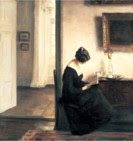This is a beautifully-produced book on a fascinating subject. I've been interested in the Anglo-Saxons ever since I first read about the Sutton Hoo ship burial. The gold & garnets, the mix of Christian & pagan objects, that helmet with the distinctive, mustachioed face looking back at me, were all captivating. Since then I've read about the Sutton Hoo dig & many other archaeological discoveries, all of them adding to our knowledge of this period. The glorious Staffordshire Hoard, discovered only a few years ago, has added to our knowledge & posed more questions at the same time.
The Anglo-Saxon period begins in the 5th century, after the end of Roman occupation of Britannia & ends with the Norman Conquest of 1066. Leslie Webster's book is divided into thematic chapters describing the different influences from Europe & beyond that created the distinctive style known as Anglo-Saxon. The Germanic tribes who settled in Britain after the Romans, the Christian missionaries sent by Pope Gregory in 597, the Celtic Christianity of Iona & Lindisfarne, the trading routes bringing influences from eastern Europe & Byzantium & the Vikings & other Scandinavian raiders & settlers.
What we think of as the characteristic features of Anglo-Saxon art is dependent on what has survived. This seems an obvious point but it's worth making as Leslie Webster does in her book. What has survived is only a fraction of what must have originally existed. If you think about the Viking invasions, the religious upheavals, the periods when Anglo-Saxon manuscripts & artwork wasn't valued, the random events such as fires & floods where so much was destroyed, it's amazing that we have as much as we do. Sometimes objects survived in Europe because they were taken there by missionaries from England. Sometimes, as with the Staffordshire Hoard, objects were buried & only rediscovered centuries later. Sometimes, the objects were grave goods. Imagine how much more could still be buried, waiting for rediscovery.
I wish I could show you every page of this book. There are over 200 illustrations in a book of just over 200pp. Almost every object described in the text is illustrated. There is magnificent gold & garnet jewellery, illuminated manuscripts decorated with interlace & animals in the initials, carved ivory caskets, stone crosses, intricate metalwork & embroidery like the Bayeux Tapestry. Webster describes the objects in detail, explaining the symbolism & imagery used & comparing it to other objects of the same period & style. Looking at the manuscripts, personal possessions & jewellery of the Anglo-Saxons is an excellent way to begin to understand the people.Webster weaves enough history into her narrative to set the scene but the focus is always on the objects. All the iconic objects are here from the Sutton Hoo helmet to the Alfred Jewel, the Lindisfarne Gospels, & the Franks Casket. There are also many objects that were new to me. This is a beautiful book written by someone who knows her subject intimately & can convey her knowledge easily.
Tuesday, November 13, 2012
Anglo-Saxon Art - Leslie Webster
Labels:
Anglo-Saxon,
art,
books,
England,
history,
Leslie Webster,
literature
Subscribe to:
Post Comments (Atom)











Sounds fascinating..love the links btw.. I never thought about the British Museum being on Facebook :0)
ReplyDeleteIt is a fascinating book. I borrowed it from the library but I'm very tempted to buy a copy. I didn't realise the BM was on FB. I must Like them!
ReplyDeleteIt does sound lovely. And if there is anyone out there who still hasn't see the Staffordshire Hoard go see it immediately! The pieces are very small, but so intricate and beautiful - the workmanship is incredible. I've not seen the collection in Stoke, but I've lost count of how many times I've stood and gazed at the objects on show in Birmingham Museum.
ReplyDeleteI would love to see the Hoard. I've read about it in the archaeology magazines I read but to see it would be amazing. I remember how excited I was to see the Sutton Hoo objects years ago.
Delete